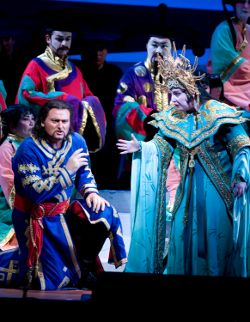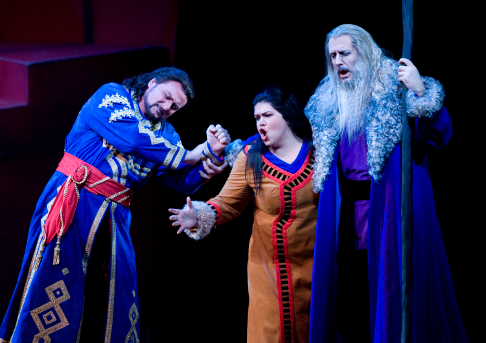![Susan Foster as Turandot [Photo by D. Ross Cameron/San Francisco Opera]](http://www.operatoday.com/turandot003.png)
20 Nov 2011
Turandot in San Francisco
The magnificent David Hockney Turandot production burst again onto the War Memorial stage with a new cast and conductor that recaptured its potential to make this fairytale into great opera.
English Touring Opera are delighted to announce a season of lyric monodramas to tour nationally from October to December. The season features music for solo singer and piano by Argento, Britten, Tippett and Shostakovich with a bold and inventive approach to making opera during social distancing.
This tenth of ten Live from London concerts was in fact a recorded live performance from California. It was no less enjoyable for that, and it was also uplifting to learn that this wasn’t in fact the ‘last’ LfL event that we will be able to enjoy, courtesy of VOCES8 and their fellow vocal ensembles (more below …).
Ever since Wigmore Hall announced their superb series of autumn concerts, all streamed live and available free of charge, I’d been looking forward to this song recital by Ian Bostridge and Imogen Cooper.
Although Stile Antico’s programme article for their Live from London recital introduced their selection from the many treasures of the English Renaissance in the context of the theological debates and upheavals of the Tudor and Elizabethan years, their performance was more evocative of private chamber music than of public liturgy.
Evidently, face masks don’t stifle appreciative “Bravo!”s. And, reducing audience numbers doesn’t lower the volume of such acclamations. For, the audience at Wigmore Hall gave soprano Elizabeth Llewellyn and pianist Simon Lepper a greatly deserved warm reception and hearty response following this lunchtime recital of late-Romantic song.
For this week’s Live from London vocal recital we moved from the home of VOCES8, St Anne and St Agnes in the City of London, to Kings Place, where The Sixteen - who have been associate artists at the venue for some time - presented a programme of music and words bound together by the theme of ‘reflection’.
'Such is your divine Disposation that both you excellently understand, and royally entertaine the Exercise of Musicke.’
‘And there was war in heaven: Michael and his angels fought against the dragon; and the dragon fought and his angels, And prevailed not; neither was their place found any more in heaven … that old serpent … Satan, which deceiveth the whole world: he was cast out into the earth, and his angels were cast out with him.’
There was never any doubt that the fifth of the twelve Met Stars Live in Concert broadcasts was going to be a palpably intense and vivid event, as well as a musically stunning and theatrically enervating experience.
‘Love’ was the theme for this Live from London performance by Apollo5. Given the complexity and diversity of that human emotion, and Apollo5’s reputation for versatility and diverse repertoire, ranging from Renaissance choral music to jazz, from contemporary classical works to popular song, it was no surprise that their programme spanned 500 years and several musical styles.
The Academy of St Martin in the Fields have titled their autumn series of eight concerts - which are taking place at 5pm and 7.30pm on two Saturdays each month at their home venue in Trafalgar Square, and being filmed for streaming the following Thursday - ‘re:connect’.
The London Symphony Orchestra opened their Autumn 2020 season with a homage to Oliver Knussen, who died at the age of 66 in July 2018. The programme traced a national musical lineage through the twentieth century, from Britten to Knussen, on to Mark-Anthony Turnage, and entwining the LSO and Rattle too.
With the Live from London digital vocal festival entering the second half of the series, the festival’s host, VOCES8, returned to their home at St Annes and St Agnes in the City of London to present a sequence of ‘Choral Dances’ - vocal music inspired by dance, embracing diverse genres from the Renaissance madrigal to swing jazz.
Just a few unison string wriggles from the opening of Mozart’s overture to Le nozze di Figaro are enough to make any opera-lover perch on the edge of their seat, in excited anticipation of the drama in music to come, so there could be no other curtain-raiser for this Gala Concert at the Royal Opera House, the latest instalment from ‘their House’ to ‘our houses’.
"Before the ending of the day, creator of all things, we pray that, with your accustomed mercy, you may watch over us."
The doors at The Metropolitan Opera will not open to live audiences until 2021 at the earliest, and the likelihood of normal operatic life resuming in cities around the world looks but a distant dream at present. But, while we may not be invited from our homes into the opera house for some time yet, with its free daily screenings of past productions and its pay-per-view Met Stars Live in Concert series, the Met continues to bring opera into our homes.
Music-making at this year’s Grange Festival Opera may have fallen silent in June and July, but the country house and extensive grounds of The Grange provided an ideal setting for a weekend of twelve specially conceived ‘promenade’ performances encompassing music and dance.
There’s a “slide of harmony” and “all the bones leave your body at that moment and you collapse to the floor, it’s so extraordinary.”
“Music for a while, shall all your cares beguile.”
The hum of bees rising from myriad scented blooms; gentle strains of birdsong; the cheerful chatter of picnickers beside a still lake; decorous thwacks of leather on willow; song and music floating through the warm evening air.
![Susan Foster as Turandot [Photo by D. Ross Cameron/San Francisco Opera]](http://www.operatoday.com/turandot003.png)
The magnificent David Hockney Turandot production burst again onto the War Memorial stage with a new cast and conductor that recaptured its potential to make this fairytale into great opera.
Well, almost a new cast. The slave girl Liu of Leah Crocetto was a hold over from the October cast though her performance in these new circumstances seemed more vibrant and vivid. No longer dwarfed by larger than life colleagues, it was far bigger than before and this time it truly mesmerized the opera house — her prayer and supplication, then her suicide came in limpid pianissimi, in rich forti, the youth and freshness of her voice embodied the purity and innocence of maidenhood.
Susan Foster was both the new Turandot and a new Turandot — not the icy, unattainable princess but the vulnerable, neurotic maiden, a Turandot very rarely revealed. Now she was a human scaled, twisted rival of the pure and gentle Liu. To be sure Mme. Foster could not be the icy Turandot if she wanted to. She does not possess the steely, dramatic voice nor the mythic persona to engage in a shouting match with her suitor Calaf. But she does have an engaging dramatic voice with volume aplenty when she needs it, and a personal softness that shone beautifully in her touching revelation that Calaf’s name was in fact “love.”
 Walter Fraccaro as Calaf and Susan Foster as Turandot
Walter Fraccaro as Calaf and Susan Foster as Turandot
Calaf too, tenor Walter Fraccaro, had a softness and vulnerability that brought a very human dimension to his “Nessun dorma” that beguiled the opera house with its intimacy and earned him one of its all time biggest ovations. His Calaf was a young warrior who was perhaps as neurotic as Turandot, both of them equating love, or let us just say sex — there is that kiss — with death. Mr. Fraccaro did have the heft and volume in secure, supple voice to assault Turandot in his second act answers to her riddles.
Bass Christian Van Horn brought physical stature (he’s tall) and volume to Timur, confidently anchoring the narrative relationships of the opera’s’ protagonists. The Hockney production does not offer this personage opportunity to expand emotionally.
San Francisco Opera Resident Conductor Giuseppi Finzi allowed Puccini’s score to rise naturally from the pit, with tempos that encouraged its huge sonic scope to saturate the War Memorial Opera house. It is a great big opera that gives the San Francisco Opera chorus and orchestra opportunity to strut their stuff as two of the world’s fine ensembles.
The musical flow revealed this young conductor’s understanding of Puccini’s story. He did not sacrifice this newly discovered delicate humanity to dramatic and musical effect — this score’s fatal temptation. But what the young maestro could not do was drive the Alfano duet that ends the opera to the musical coherency that his predecessor Nicola Luisotti miraculously achieved, nor bring point and edge to the machinations of Ping, Pang and Pong.
 Walter Fraccaro as Calaf, Leah Crocetto as Liù and Christian Van Horn as Timur
Walter Fraccaro as Calaf, Leah Crocetto as Liù and Christian Van Horn as Timur
The Hockney production is saturated with Chinese reds and fantastical shapes that evoke much more than illustrate a sense of Oriental splendor. Hockney thinks two dimensionally, i.e. the proscenium opening is a canvas, thus we are presented with a succession of paintings. This places his characters on the canvas, or rather it freezes them onto the canvas. There is little movement, and virtually no dramatic reality, i.e. characters do not speak to each other — conversations are a visual, public presentation. Puccini’s Turandot offered this formidable visual artist unique opportunity to create a masterpiece.
Michael Milenski